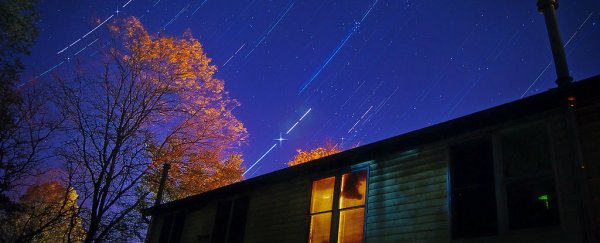October is a special month for astronomy lovers, because around this time every year, Earth passes through the tail of debris left behind by Halley's comet.
The result is what NASA calls "one of the most beautiful showers of the year": the Orionid meteor shower. This shower lasts until November 22, but don't wait to get out there and look up, because it's about to peak this weekend.
The Orionids will hit its peak between midnight and dawn on the morning of Saturday October 21 – but there'll be great viewing Sunday early morning, too.
This is when both the northern and southern hemisphere will get a chance to see up to 20 meteors per hour burning up in Earth's atmosphere all night long.
These meteors are known as Orionids, because they appear to emanate from a region to the north of the second-brightest star in the Orion constellation – Betelgeuse.
They were originally meteoroids, formed from the remnants of the nucleus – or rocky core – of Halley's comet. Since breaking apart from the comet, they've remained as a swirling cloud of rubble, shadowing it as it orbits the Sun every 76 years.
As Earth passes through this dirt cloud twice a year, these meteoroids burn up in our atmosphere to become meteors – otherwise known as shooting stars.
The Orionid meteor shower is famous for its first meteors – they travel at about 148,000 mph (66 km/s) into Earth's atmosphere, according to NASA.
This means they can leave radiant 'trains' in their wake that last several seconds and up to minutes. These fast meteors can also produce fireballs, which are meteors that shine extremely bright for a few seconds before fading.
For the best chance of spotting the meteors, you've got to think strategically – meaning don't just step onto your balcony and wonder where all the shooting stars are, find somewhere with low light pollution, lie back, and wait.
Check out this light pollution map to help you find a good viewing spot.
"Come prepared with a sleeping bag, blanket, or lawn chair," NASA explains.
"Lie flat on your back with your feet facing southeast if you are in the Northern Hemisphere or northeast if you are in the Southern Hemisphere, and look up, taking in as much of the sky as possible. In less than 30 minutes in the dark, your eyes will adapt and you will begin to see meteors."
"Be patient – the show will last until dawn, so you have plenty of time to catch a glimpse," the space agency adds.
You'll also need to find the Orion constellation in the sky so you know where the meteors are going to appear (called the radiant), and the easiest way to do that is to look for Orion's belt – three stars that are pretty much evenly spaced in a straight line.

Once you find the radiant, don't look directly at it, but find a dark patch of sky around 45 to 90° away from it to focus on. "They will appear longer and more spectacular from this perspective," says NASA.
Happy viewing!
